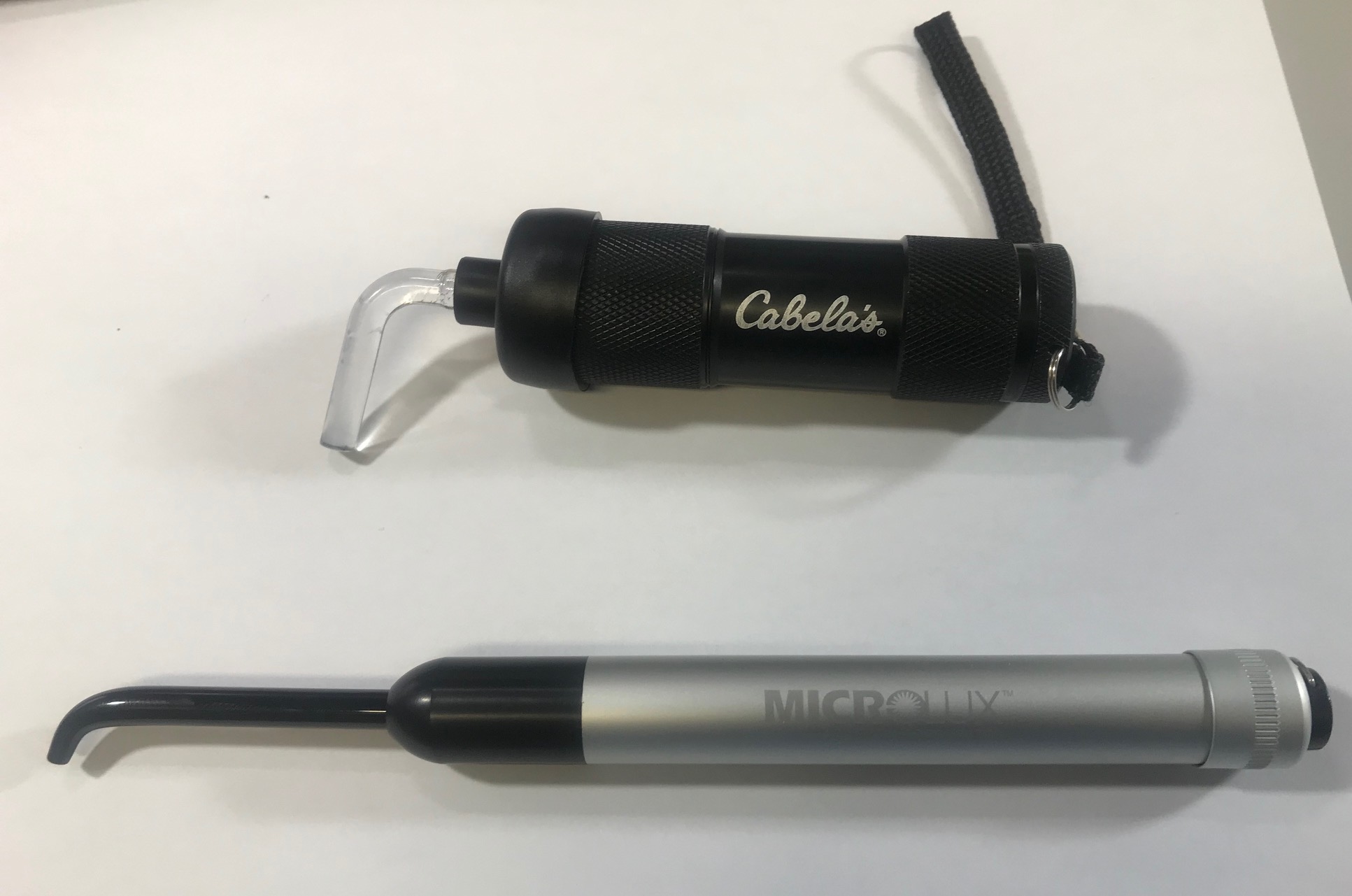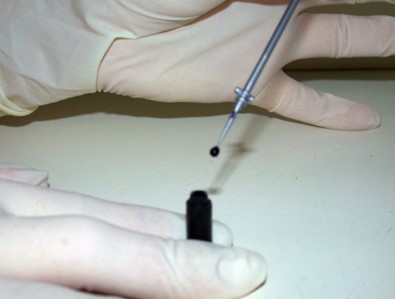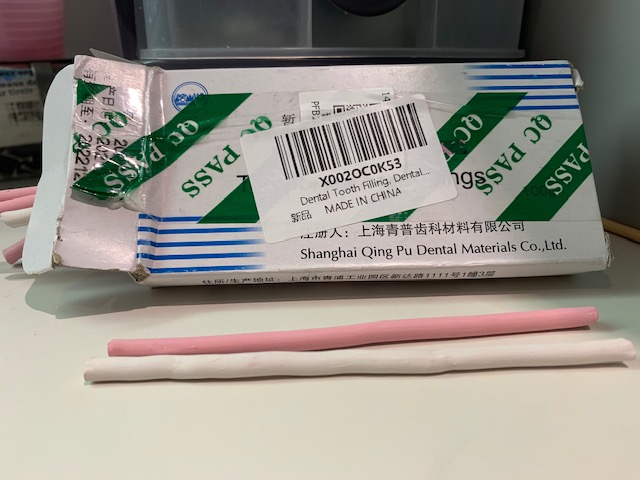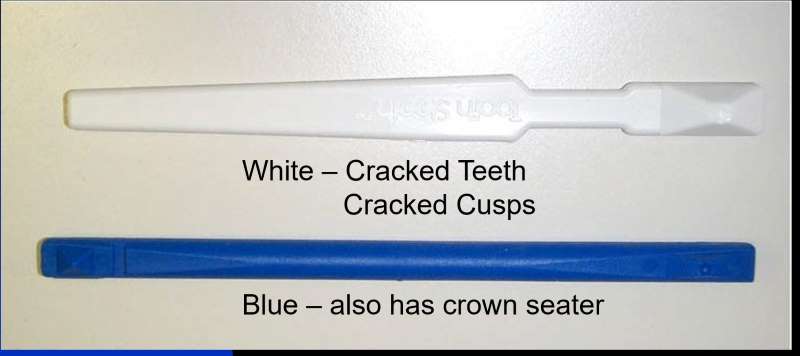Carestream 6200
Our initial involvement with digital radiography dates back over 25 years with Schick sensors. Since then, we moved to Kodak (now known as Carestream) which integrates very well with TDO, our clinical imaging and Endodontic practice management software. Image quality is very good, and the sensors are durable. When considering ANY digital radiographic sensors, it is important to examine the physical characteristics of the connection. This is the weak link in most connectors – the wire interface to the connector itself. Cracking, metal wire fatigue and loss of connectivity can render a perfectly good sensor useless or needing expensive repairs. With USB integration now standard, any sensor you choose (and there are many) should be “plug and play”.

Figure 1 :
Digital Radiography Sensors by Carestream
Sensors Size 1 and 2 shown
Carestream 9000
Our office was one of the first in Western Canada to install the Kodak/Carestream 9000 focused field Cone beam cbCT machine. It has proven to be very reliable and has (so far) required minimum maintenance.
I find the Carestream software very intuitive and patients find it easy to understand when they we review the images with them. Image quality is good for endodontics but as with any cbCT image, quality is influenced by adjacent alloys, implants and radio-opaque materials. cbCT imaging has become the endodontic standard and must be considered an essential part of contemporary endodontic practice.

Figure 2: Carestream/Kodak 9000
Focused Field 3D imaging device
Manufacturer: Carestream
Website:
Cost: Depends on Field of Scan (Full Head vs. Focused Field)
Microlux Transilluminator
Transillumination is an important clinical test when we are considering teeth that may be fractured. Some clinicians remove the Bur from their high speed handpiece and attempt to use the fiber optics built into them to accomplish this. In certain cases, it is illuminating a single cusp or more frequently, illuminating the buccal or lingual surface of his tooth to examine for mesio-distal fracture.
It is best to use a dedicated device that transfers the maximum amount of light to the tooth to illuminate fractures. The Microlux Transilluminator is approximately $200 US and is extremely easy to use.

Figure 3a : Microlux Transilluminator
A dedicated device used to check for cracks and fractures

.Figure 3b : Microlux Transilluminator
A “Bore Sight” ( pictured on top – and used for sighting down rifle barrels)
can be purchased at gun stores for about $10. It uses a 90 degree fibreoptic attachment. Although the light may not be as strong as the Microlux, it can serve as a very economical substitute.
Endo Ice – by Hygienic
Classic endodontic vitality tests always involve the use of thermal stimulus. Endo Ice is one of the most convenient and consistent ways to deliver extremely cold temperatures to the tooth. A small amount is sprayed onto a cotton pellet, which is applied to the tooth. It is important to understand that this stimulus is extremely cold and care must be taken not to replace it on the labial surface of the aesthetic zone because it can cause enamel crazing.
Ideally, cold is applied directly to the tooth but it can be applied to restorations such as amalgams or crowns where we suspect elevated hypersensitivity due to pulpitis. It is important to remember that the test is refractive and that continued application of any cold stimulus to the tooth will result in less and less response with each application. Should you wish to repeat the test, it is best to allow the tooth to return to ambient body temperature before trying to reconfirm the results of the previous test.

Figure 4a : EndoIce by Hygienic
Classic cold test refrigerant
Manufacturer: Hygienic Corporation
Website: check your local dental supplier
Cost: approx $30 CDN
Some clinicians suggest creating “ice pencils”. This is done by filling used anesthetic carpules or plastic needle covers with water and then putting them in the freezer. The ice pencil is released by warming the carpule or cover with you hand and then putting the frozen water “pencil” on the desired tooth surface. I found that it can sometimes drip on to adjacent teeth or the gingiva and give a false reading. I prefer Endo Ice, which is a more focused, albeit colder, version of the test.

Figure 4b : Ice Pencil
Ice Pencils are created by freezing water in capped anesthetic carpules. A piece of floss is dropped into the carpule to ease removal after freezing.
Methylene Blue Dye Vista-Blue
Clinicians who perform endodontics often need to establish the extent of the fracture to determine whether the tooth merits treatment or restoration. Staining the crack often makes the difference between deciding to keep the tooth or recommending extraction. This Unidose single application method of methylene blue dye is very convenient to use . It was originally developed by the late Dr. Joseph Dovgan. The dye is applied to areas of suspected cracks, which highlights them and allows them to be examined, visualized and photographed more easily. It should be a routine part of the clinician’s armamentarium if they are routinely treating cracked teeth.

Figure 5: Vista Blue
Methylene Blue Unidose with applicator

Figure 6: Vista Blue
Methylene Blue applied to tip
Carr Mirrors
Good scope photography requires the use of high-quality mirrors which reflect the limited light available in the deeper portions of the tooth. Sapphire HD Mirrors, developed by Dr. Gary B. Carr, provide exceptional clarity and reflection that reflect 99% of visible light. Carr mirrors are an excellent way to get the light to where you wanted and are ergonomically designed to bend to allow for easy access. They are available through EIE2.com in various sizes and shapes.. Please note that the original mirror design can only be sterilized with non-glutaraldehyde sterilizing solutions like Compliance or Sporox. Newest versions(2021) ARE autoclavable.

Figure 7 : Carr Bendable Mirror
Available in various sizes and shapes
Dental Stopping
Hygienic brand dental stopping used to be the standard material used for heat tests after baseplate gutta percha was no longer available. It is my understanding that the Hygienic Corporation has also stopped manufacturing this material, although generic versions are available on Amazon from China (below)

Figure 8: Hygienic Dental Stopping
No longer available
Used for heat testing

Figure : Generic Chinese Dental Stopping
Used for heat testing
Manufacturer: Hygienic Corp. (No Longer Available) See Shanghai Qing Pu for substitute
Website: Amazon.com
Cost: Chinese version $78 CDN/Box
JW 17 MicroExplorer
The JW 17 MicroExplorer was originally manufactured by Dr. John West . It has a much smaller tip size and much thinner diameter than a standard DG16 endo explorer. They allow for deeper exploration of orifices and better tactile sensation in calcified canals. However, these Explorers must be used with a light touch because they can bend quite easily, and they are far more expensive than the standard DG 16.
Other clinicians have come out with similar models. I rarely use them, but they do come in handy occasionally when canals are extremely small and standard Endo explorers are too large.

Figure 9: JW17 Microexplorer
A double sided smaller version of a DG16 Endo explorer
Pictured here which is the MicroExplorer – part of Dr. Steve Buchanan’s Terauchi file removal kit
www.delendo.com/collections/terauchi-file-retrieval-kit/products/micro-explorer
($65 US each )
Tooth Slooth
The original Tooth Slooth® fracture detector was first introduced to the dental industry in 1984. Increased numbers of teeth with CTS (Cracked Tooth Syndrome) mean that we always have to be testing for weak cusps and possible fractures. The Tooth Slooth is another essential tool for detecting weak cusps and fractured teeth. There are two versions: The white version pictured is used to apply pressure to each individual cusp. The cusp tip is seated in the depression and the patient is asked to bite. Cracked cups are indicated with a reproducible sharp response to pressure. The doubles-sided blue Tooth Slooth is also available and has a smaller version of the white Slooth one one side and a pointed crown seater on the opposite end.

Figure 10: Tooth Slooth
Used for testing teeth for cracked cusps and fractures
Manufacturer: Professional Results Inc.
Website:
Cost: Approx $30 CDN/4 Pack
Cotton Roll
Another basic but useful tool for cracked tooth/cusp detection is the cotton roll. The patient is asked to clench on the cotton roll as it is moved from one occlusal surface to the next. Cracked teeth respond to this test with a reproducible sharp discomfort upon release. Some clinicians have recommended the use of a small rubber wheel or bb-shot covered in tape. I prefer this method. Why? Using a cotton roll is cheap, reliable and fast…a rare commodity in any dentally related product. Cotton Rolls will sometimes give you better results than a Tooth Slooth because it molds more closely to the occlusal surface.

Figure 11 : Standard Cotton Roll
Sometimes can be better than a Tooth Slooth for testing for cracked teeth.
